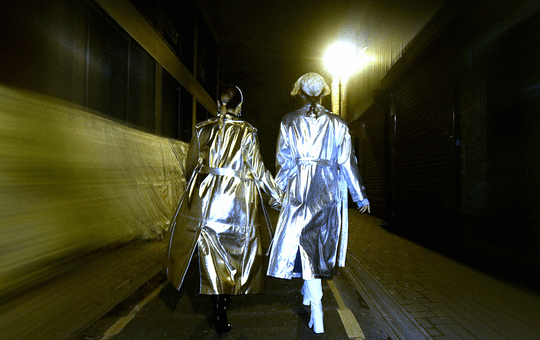The video artist making dancing about architecture
Peckham Artist Moving Image Festival – or PAMI, affectionately, for short – is an annual festival in its second year that celebrates artists exploring the moving image in a variety of forms. Exhibiting across Peckham’s sprawling network of studio spaces, plotted on this handy map, it brings to life the extent to which the south London district has become something of an art hub over the last couple of years. Alongside the debut broadcast of a local pirate television station and real-world displays of digital wallpaper, one of the most exciting exhibits was a piece by French artist Pauline Beaudemont. In the concrete surrounds of the Bold Tendencies carpark location are five television sets, positioned in a triangular layout (scroll down to see what I mean). On each screen a female dancehall dancer performs an overtly sexual, repeated movement in a different room of an empty, sterile-looking house. There’s a magnetism that builds in the looping of each dance movement, magnified by the multiple television screens acting almost as a troupe of dancers, that lends a spiritual edge to the piece. Is the dancer performing some ancient ritual, blessing each room in the house? Her movements are set against the distorted, slurred rumble of slowed-down footwork music, a juxtaposition that’s all the more startling when you learn that the house she’s dancing in was built by Swiss architect and writer Le Corbusier for his parents in 1912. It’s a thrilling piece that teases questions about space, movement, sexuality and formality with wit and grace, and if you’re in the London area this weekend you should really get along to see it. I dropped artist Pauline Beaudemont a few questions to find out about what inspired it and future projects including a go-go documentary with Kindness.
Please tell me a little bit about yourself and your practice?
Pauline Beaudemont: I’m an artist currently based between London and Geneva. All of my art is really just an excuse to build things and go to B&Q.
Could you introduce the new video piece and provide some background on what you wanted to explore with it?
Pauline Beaudemont: The piece is called “If you put a roof on…”, a reference to the city in which it was filmed, and a quotation from Le Corbusier about his hometown. He said that if you put a roof on La Chaux de Fonds, it would be the biggest “bordel” in the world. “Bordel” in French meaning both a huge mess and a brothel. Given the opportunity to work in a house he built, I wanted to examine human forms and how they move through architecture following his Modulor theory. Using dance allowed the re-insertion of animation to very cold and unanimated environment.
I have been invited by curator Nina Cristante to show the film at Bold Tendencies during PAMI this week and I have decided to exhibit it as a sculptural installation rather than a traditional screening. I’ve used precast concrete elements as pedestals for the monitors which all accentuate the plasticity of each sequence of the film and the life size projections on the walls allow the viewers to penetrate into these tableaux vivants.
How and where did you film it – and how was it?
Pauline Beaudemont: The Maison Blanche is the first house of Le Corbusier built for his parents in 1912 in his home town in Switzerland. You can see in it his beginnings as an architect, and also the incongruous detail left by the interior decoration of his mother. The loops were filmed on 16mm.
What drew you to working with a dancehall dancer?
Pauline Beaudemont: Le Corbusier, though notoriously mysogynist, was often inspired by the female form in his own paintings and sculptures, and its resonance can be felt in his architecture. In terms of dancehall, I was attracted to the sexuality and physicality of dancehall dances and clips of competitions on Youtube. I asked Amzone, a famous French dancehall queen to participate in the piece and she agreed. She was interested in using her own physical potential in an artform and environment unrelated to the competitions and nightclubs in which she generally needs to perform.
I really liked the repeated movements – what do you like about repetition?
Pauline Beaudemont: Even though the movements stem from dancehall, repeating one individual motion removes it from a choreography or dance significance, and makes it abstracted enough to stand at a distance from the musical culture which inspired it. The body of the dancer becomes a fundamental moving form.
I understand that the music is slowed-down footwork – could you tell me a bit about the motivation for that?
Pauline Beaudemont: The soundtrack tries to reflect the same sense of sound removed from the culture which inspired it. In the installation, all of the treble is filtered away, leaving the impression of a club playing music below the piece, rather than in the same room. Slowing down the footwork tracks was freeing them from the tempo which makes them recognisable. I wanted to use bass since it affects people on an instinctive level.
And finally, what else do you have coming up that we can look forward to?
Pauline Beaudemont: I’ve just published an artist edition of my photo work through Hard Copy in Switzerland, and I’ve just made a documentary about go-go music with the musician Kindness, filmed during a recent trip to Washington DC.
Pauline’s video installation is on exhibit at Bold Tendencies in Peckham from 11am-10pm until Sunday 23rd October as part of PAMI Festival 2012















